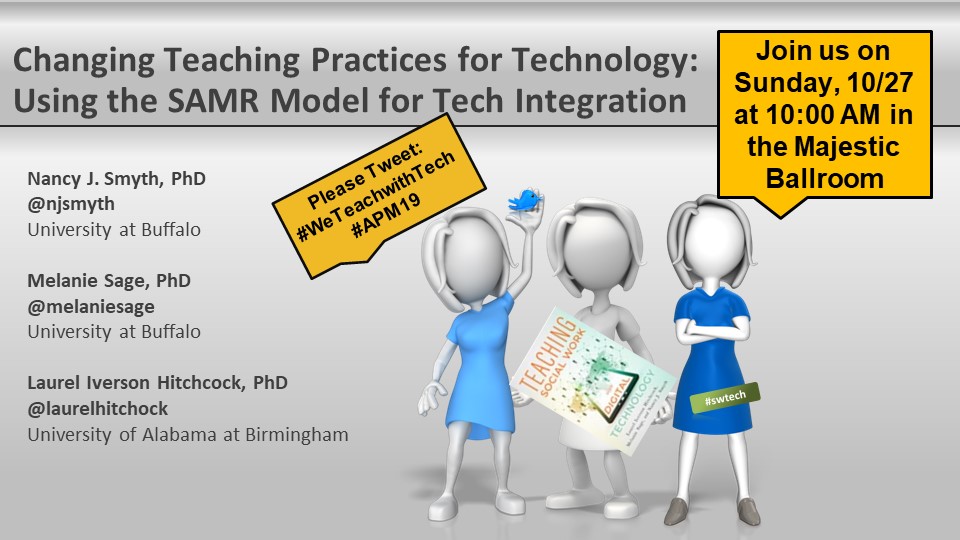#APM19 – Evolving the Signature Pedagogy with the Social Media Toolkit for Field Educators

On October 27, 2019 at 8:45 AM, during the Annual Program Meeting for the Council on Social Work Education in Denver CO, Mary Jacque Carroll, Allison M. Curington, Robyn V. Snider and I will be presenting on information and tools that field directors can use to guide curricular development and assessment strategies around interprofessional communication with digital and social technologies. If you are still in Denver, please come find us in Governor’s Square 11 – Plaza Building of the conference hotel. We’ll also be sharing how you can develop your own professional social media policies to support communication with students and field agencies as well as how to create activities for students in field to increase understanding of the ethical use of social and digital media in social work practice.
You’ll also learn how to access the Social Media Toolkit for Field Educators, a free resource with educator’s guide and a PowerPoint slide deck.
#APM19 – Changing Teaching Practices for Technology: Using the SAMR Model for Technology Integration

On October 27, 2019 at 10:00 AM, during the Annual Program Meeting for the Council on Social Work Education in Denver CO, Melanie Sage and I will be sharing some insights from Chapter 4 of our book, Teaching Social Work with Digital Technology, co-written with Nancy Smyth. If you are still in Denver, please come find us in the Majestic Ballroom –Tower Building of the conference hotel. We will be sharing how Puentedura’s SAMR Model for Technology Integration can be used to incorporate technology into traditional social justice assignments in social work education. There will also be time to adopt one of your current assignments using the SMAR Model.

Additionally, we’ll be talking about our virtual book group that will be launch in January 2020. You can read more about it here:
For those of you who cannot make the presentation, we are including the details in this blog post.
Teaching Social Work with Digital Technology Book Group

If you teach social work with technology, either online or in a traditional classroom, we (Melanie, Nancy and Laurel) invite you to learn with and from peers in this free book group – Teaching Social Work with Digital Technology. Goals of this virtual book group are to: 1) create a supportive learning community; and 2) provide space for reflection about one’s own professional development with teaching with technology.
This group will run from January to June 2020, with monthly meetings and a moderated online private Facebook group. The group will include live virtual meetings, with discussion moderated by an author and a guest educator. In between meetings, social work educators will lead and moderate book discussions, and offer reflective questions and simple learning tasks. Participants should have access to the book by January 2020. The schedule follows:
Three Ways to Model Good Boundaries with Technology in Social Work Ed

The National Association of Social Workers’ (NASW) Standards for Technology in Social Work Practice (2017) offer a number of standards for social work educators and practitioners. One of these standards focuses on maintaining boundaries with our students. This is not a new ethical practice for social work educators; we have always worked to maintain boundaries with our students. Rather, the challenge has been navigating these boundaries in virtual spaces as technology has changed when and how we can communicate and engage with each other.
Not surprisingly, the tech standard from NASW focuses on the social work educator taking precautions. Managing risk is a good idea, and I would suggest that we also embrace the affordances that digital and social technologies can offer our students, our classrooms and our own professional development. The big question for most of us is how to do this in ways that are comfortable, manageable, and ethical. Over the past few years, many social work educators have contributed their knowledge and expertise to this blog about how they engage students around technology in their classrooms. In this post, I have pulled together some of their suggestions for how you can model good boundaries with technology in your teaching practice.
Tips for New Online Social Work Educators

Editor’s Note: Melissa Thompson, MSW is a lecturer at Dominican University in Chicago, IL, and tweets at @mmt98. Nathalie P. Jones, PhD, MSW is an Associate Professor of Social Work at Tarleton State University and tweets at @Dr.NJones. In this blog post, they share their best tips for social work educator who are new to online teaching.
According to the National Association of Social Workers’ (NASW) Technology Standards for Social Work Practice (2017), social workers are urged to use technology in an ethical manner for practice and learning environments. In higher education, we hear about “digital native” students, who have grown up with a life centered on technology and who present as digital super humans. However, research is increasingly showing this concept to be a myth, and that designed learning environments focused on this myth can lead to poor learning outcomes (Kirschner & De Bruyckere, 2017). Another myth we often see among social work educators is the perception that non-traditional students are resistant to the use of technology in the classroom. Recent data from the Council on Social Work Education’s (CSWE) National Workforce Data Brief (2018) shows this to be a myth as well, reporting that when it comes to online education in social work, the highest enrollment rates were non-traditional students.
Digital Advocacy in the Social Work Classroom: Students speaking out online


Editor’s Note: Julia Kleinschmit is a clinical associate professor in the School of Social Work at The University of Iowa, and Breanne Benson is a currently MSW student in the School of Social Work at The University of Iowa. In this blog post, Julia writes about an assignment that uses social media to promote advocacy skills and professionalism among social work students. Breanne offers her experience with the assignment as a student and reflects on how she grew her skills as a future social worker. Julia can be found on LinkedIn, and Breanne is on Instagram at _bmbenson.
Addressing Technology in Changing Social Work Environment
The Council on Social Work Education’s (CSWE) Competency 1: Demonstrate Ethical and Professional Behavior requires social workers to use technology ethically and appropriately to facilitate practice outcomes. Many have focused on the need for confidentiality in electronic communication and social media boundary management. These are important issues, but at the University of Iowa’s School of Social Work, Megan Gilster, Stephen Cummings, and I believed we could also teach MSW students to use their online identities and social media as powerful tools for effective advocacy.


